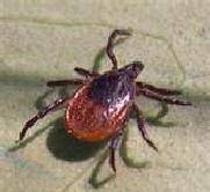It's a New Day in Public Health.
The Florida Department of Health works to protect, promote, and improve the health of all people in Florida through integrated state, county, and community efforts.
Ehrlichiosis and Anaplasmosis
Florida Health
Disease Control- DiseaseControl@flhealth.gov
- 850-245-4444
-
Florida Health
4052 Bald Cypress Way
Tallahassee, FL 32399

Several species in the genus Ehrlichia can cause disease in humans. Human illness caused by the pathogen Ehrlichia chaffeensis is referred to as Human Monocytic Ehrlichiosis (HME). It is transmitted by Amblyomma americanum, also known as the lone star tick, which is one of the most commonly encountered ticks in the southeastern United States. Ticks become infected by feeding on white-tailed deer or other animals and can transmit the disease to humans or dogs at a subsequent feeding.
What was originally thought to be a second species of Ehrlichia was recently reclassified as Anaplasma phagocytophilum, which causes Anaplasmosis or Human Granulocytotropic Anaplasmosis (HGA) in humans and is transmitted by Ixodes species ticks, such as I. scapularis, the black-legged tick that transmits Lyme Disease.
- Symptoms and Treatment
- Ehrlichiosis and Anaplasmosis Geographic Distribution
- Resources and References
Symptoms
Some people infected with E. chaffeensis or A. phagocytophilum may have no symptoms, or have symptoms so mild that they do not visit the doctor. For those who do become ill, symptoms typically begin 5 to 10 days after a tick bite, and can initially include fever, headache, fatigue, and muscle aches. Other signs include nausea, vomiting, joint pain, diarrhea, and confusion. Adults with Ehrlichiosis or Anaplasmosis typically do not develop a rash, however with Ehrlichiosis a rash is reported in up to 60% of ill children.
HME and HGA can be hard to diagnose because many of the symptoms look like those seen for other diseases. It is important to tell the physician about any tick bites that have occurred. Both diseases can cause severe illness with as many as half the patients needing to be hospitalized. Approximately 2% of people who become ill with HME die from the disease and less than 1% with HGA.
Treatment
Cases detected early in the course of disease can be treated with antibiotics. Research has shown that removing attached ticks within 24 hours of the bite can greatly reduce the chance of infection. For this reason it is important to check for ticks on a regular basis and to remove them right away.
HME caused by E. chaffeensis is found primarily in the southeastern part of the U.S. Cases are commonly reported from Missouri, Oklahoma, and Arkansas. Areas with reported HGA cases correspond with the geographic distribution of Lyme disease.
HGA is more likely to be acquired outside Florida and is more prevalent in the northeast United States. Like Lyme disease, HGA has less than half (45%) of cases classified as Florida-acquired. The number of cases increased during the spring and summer months, though cases are reported in Florida year-round.
Ehrlichiosis Epidemiology and Statistics | Ehrlichiosis | CDC
Resources
Ehrlichiosis Epidemiology and Statistics | Ehrlichiosis | CDC
Epidemiology and Statistics | Anaplasmosis | CDC
References
McQuiston JH, McCall CL, Nicholson WL. Zoonosis Update:Ehrlichiosis and related infections. JAVMA 2003.
*Note: This page contains materials in the Portable Document Format (PDF). The free Acrobat Reader may be required to view these files.



Connect with DOH